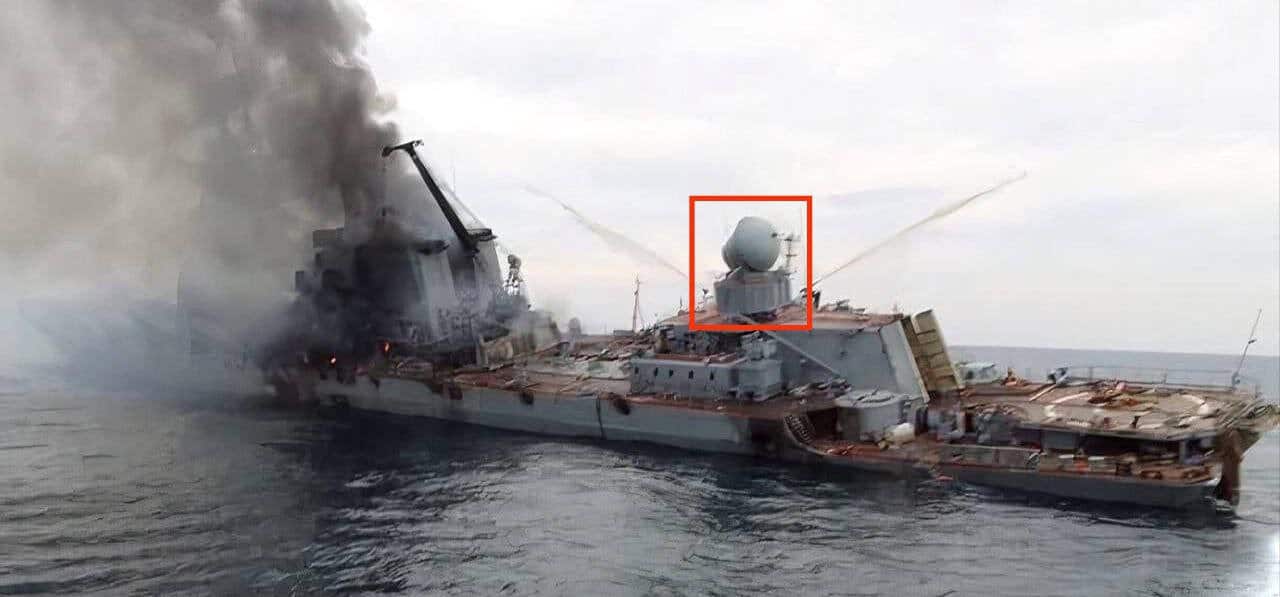The missile cruiser Moskva was the largest warship of the Black Sea Fleet of the Russian Federation and belonged to three ships of Project 1164 Atlant guided-missile cruisers, which were created to destroy enemy carrier strike groups.
The loss of a ship of this class for Russia still matters, not only because of its status, but also from a military point of view. At the same time, some circumstances of the Black Sea Fleet flagship’s death still remain cloaked in mystery.
On February 24, 2022, during the Russian invasion of Ukraine, the warship was involved in the capture of Snake Island: it served as a command post in the formation with the frigate Admiral Essen and the patrol ship Vasily Bykov. These ships carried out the blockade. The Moskva cruiser was the ship on which the Ukrainian border guard said: “Russian warship, go fuck yourself.”
On February 24, Ukrainian border guards refused to surrender, and at about 18:00 an attack on the island began. The cruiser Moskva bombarded a section of land with the ship’s АК-130 gun. The strike destroyed most of the buildings on the island.
At 22:00, after several hours of battle, the State Border Guard Service of Ukraine announced that the Russian invaders had captured the island.
According to some reports, later the Moskva cruiser also participated in the naval blockade of Odesa, Mykolaiv and Ochakiv.
On the evening of April 13, 2022, the Ukrainian military struck the Russian cruiser with Neptune cruise missiles in the area of Snake Island and inflicted serious damage on it. And on the evening of April 14, the Russian Ministry of Defense reported that the cruiser sank while being towed to its port of destination.
An analysis of radar satellite images of the northern Black Sea on April 13 revealed a sunk ship. The ship, corresponding to the size and position of Moskva, was geolocated there (45°10″43.39″N, 30°55″30.54″E).
This position was located east of Snake Island, 150 kilometers from Odesa and 90 kilometers from the Ukrainian coast.
Timeline
On April 13, at about 16:00, the Ukrainian military detected the Russian missile cruiser Moskva, standing 120 kilometers offshore in the area of Snake Island in the Black Sea.
Immediately after verifying and acquiring targets, the missile system operators launched two R-360 missiles.
A video of the launch of these anti-ship missiles, which presumably sank the Russian missile cruiser Moskva was published for the first time on the first anniversary of the incident.
On April 13, 2022, Ukrainian media and politicians began to publish statements that the missile cruiser Moskva was hit by two Ukrainian-made Neptune (R-360 – ed.) missiles.
A few hours later, on April 14, the Russian Defense Ministry announced a fire on board the cruiser. The report said that ammunition detonated due to a fire on board the cruiser. The Ministry of Defense didn’t name the causes of the fire, just mentioned that it was “being investigated.”
Later, the Ministry stated that the fire on board the Moskva was localized, and the affected ship was towed to an uncertain port, possibly to a naval base in Sevastopol in the occupied Crimean Peninsula. All this was happening amidst rumors about the ship’s sinking.
On the same day, April 14, the first photo of the mutilated ship taken from the board of the Russian rescue tug Shakhter, arriving to the aid of Moskva, appeared on the web.

The published photo showed that the cruiser had two breaches just above the waterline in the area of the helicopter hangar and funnel. The funnel hit led to massive destruction, fire and heavy rolling to the port side due to flooding, but there were no traces of detonation of ammunition.
From this moment until mid-afternoon on April 14, the ship continued to burn.
It was obvious that before the sinking, the Moskva burned out from the inside: strong smoke was coming out of most side scatters on the left side of the ship, and obviously it followed a large scale of fire in the interior.
The ship’s boats, which were stored outside at the rear of the ship, near a helicopter hangar, were absent. The helicopter hangar door was also open, and a crane was rotated, which indicates the evacuation of the ship’s crew.
In the evening of the same day (around midnight on April 14), the Russian Ministry of Defense reported that during the towing of the cruiser to the port of destination, the ship lost stability and sank in the storm. The initial cause: hull damage after the detonation of ammunition.
However, according to meteorological data, there was no storm on that day, and the height of the wave was about 1 meter, the wind speed was about 14 knots, indicating mild weather.
The Operational Command “South” of the Ukrainian Armed Forces then published the interception of radio messages of the flagship’s crew after two missiles hit the side of the ship. Presumably, that were the first minutes after the hit that were documented
“Moskva – the First – two holes, the screw stopped, burrowed, lies on its side…,” said the ship’s radio operator.
He reported that the ship received holes below the waterline, the ship’s roll was 30 degrees, and the deck-bridge was cut off (presumably by a severe fire).
“There is no way to tow, we carry out rescue of the crew,” can be heard on the recording.
Possible details
According to an article published by Ukrainska Pravda, the Russian flagship sank on a rainy, cloudy day, which, presumably, created ideal conditions for two missiles of the Neptune system to reach the ship and sink it.
According to the media sources, the weather over the sea created conditions under which the signal from the radar of the anti-ship system saw the target. The signal was reflected from the clouds to the surface of the water, and from there back to the clouds, and in such a corridor the radar “locked on” the Moskva and was able to target missiles.
Reasons for the defeat of the cruiser Moskva
The main question in this story remains why two missiles were not shot down during the passage of the air defenses of the Moskva cruiser.
The cruiser’s air defense systems included powerful medium-range S-300F SAM, Osa-M short-range, and anti-aircraft guns, which formed three echelons of defense against air threats. The first missile was to meet the S-300F system with a range of up to 75 kilometers (5V55 missile). In case of a defense breakthrough, at a distance of 10-15 kilometers the target met one of the Osa-M SAMs, and in the case of bypassing the defenses of this system, the last line was the АК-630 six-barreled 30mm gun fire.
The main disadvantage of this multi-layer air defense system was the low interception altitude of missile systems. The minimum altitude of interception of S-300 Fort targets declared by the manufacturer was 25 meters, which was due to the vertical launch system and the need to speed up for the missile.
Such a disadvantage became fatal while intercepting Neptune anti-ship missiles. They descend to an altitude of 3-5 meters above the sea surface in the flight’s terminal part in order to be unnoticed for as long as possible in the field of view of the ship’s radar.
Interception of missiles at a low altitude in the short range should be provided by one of the two Osa-M systems, the minimum interception altitude of targets, which was 5 meters, and should be enough in theory. However, it was worth considering the height of the installation of the system above sea level, which was 15-20 meters.
The last protective thing for the ship from an air threat could be the dense fire by four АК-630 guns, the rate of fire of each was 5000 rounds per minute. These systems were controlled by the MR-123 Baghira fire control system, which was capable of automatically detecting, tracking, and firing at high-speed targets using radar and optical stations.

Fatal malfunctions
On April 20, 2022, an anonymous article with an eye-catching headline was published in Russian social media. “The Moskva crew was betrayed” contained scans of the certificate of technical condition of the missile cruiser Moskva dated February 10, 2022.
The document had important information about the unsatisfactory condition of many critical systems and units. This indicates the ship’s low combat readiness, including its air defense systems.
The certificate listed a number of faults in the missile and artillery units of the ship’s air defense systems:
S-300 Fort SAM – during check of the electronic shot (blank round – ed.) after target lock on, there was no binding of missiles to the target. The display on the FI231K device didn’t light up. There were no visual information on the situation indicator when the receiving and transmitting channel No. 1 operated. The ФFE21A device was faulty. The protection element’s fuses blew, igniting the fault. The operation of the CVM device No. 1,2 was unstable. The “Test FK” mode didn’t pass. The fault (channel 1) indicated on the FV27F device, when it went to high deployment. The FI234K was curved on the unit.
Osa-MA SAM No. 1 – antenna post – no radiation at TDS (target detection station).
Osa-MA SAM No. 2 – requires FK-1 adjustment, there was no locking of the TDS antenna, a constant signal of the simulated target on the range indicator.
AK-630 No. 1 was a faulty control unit, there was no voltage of 27 volts, it was necessary to replace the Ао-18 No. 3 machine due to the maximum deterioration of the barrel.
Malfunctions of radar units in air defense systems:
MR-800 is a Soviet and Russian long-range radar surveillance system designed to detect aerial targets. The system consists of two radar stations, the antennas of which are located in antenna landings on the back sides of each other. Works in combination with the S-300F SAM.
Faults: device No. 2P-1 (first channel) non-operating subblocks V110-1 FIT. Required repair of subblocks, the second stage of the first channel is not turned on: device No. 2 (1 channel), the gap of the textolite plate, the necessary replacement of bearings on АТТ-50-400 No. 2 (II channel), the АТО-20-400 (standby) during operation was unauthorized to turn off, the machine of protection of the unit was triggered, the 1 channel of the device 2-О (1) was a faulty heat exchanger, the 1-2 channel device 14-2 the ZVA unit did not set the speed.
MR-123 Bagira is a Russian naval artillery fire control system. The system is designed to control the АК-630 anti-aircraft guns. Provides fire on aerial targets, including low-flying ones.
MR-123 No. 1 (nose) – no TV focusing on device No. 3.
MR-123 No. 2 (port side) – unauthorized voltage drop when switching from “Manual” mode to “Search” mode.
MR-123 No. 3 (starboard) – no image on the TV set, the beam width in the “Locking-on” and “Automatic” modes didn’t meet the specifications. There was no indication of “Scanner ON” test lamp. On the KAP panel of device No. 3 (there is no beam scanning), device No. 1 was not controlled at the angle of place.
So, the ship went to sea with a number of serious malfunctions in the system of long-range radar detection of MR-800, some of the operations were performed on backup systems. Problems were also present in the functioning of the S-300F.
One of the Osa-M SAM systems (No. 1, presumably on the port side) could not detect targets and was inoperable, while the second system had issues with the detection system, as well as the target indicator, needed to configure subsystems.
The nose АК-630 fire control system could not reach the target via an electro-optical channel due to issues with the vizier, АК-630 on the port side had difficulties in the power system and could fail during operation.
It should be noted that the photo of the affected cruiser clearly shows the 3R41 Volna radar returning to the derived position, which was supposed to track the detected air target. The fact that the radar antenna did not look towards the left side, from where the missiles arrived, made us suggest at least that the MR-800 radar did not detect the launch and flight of targets until the moment of hitting. But as a maximum – that one of the radar systems was turned off/faulty.

Crew negligence
The Moskva cruiser had the necessary systems for detecting and intercepting air threats. However, in addition to technical capabilities, personnel training is also important, which should be at a very high level, since ships have only a few minutes to respond after the missile is detected: all necessary measures should be implemented as quickly as possible, which only well-trained personnel can do.
According to Russian documents for internal use, 248 freshly conscripted sailors served on board the cruiser, which, obviously, had a negative effect due to the low level of their qualification. The Russian Ministry of Defense does not name the number of conscripts, but has officially admitted their presence.
The S-300F anti-aircraft missile system, located on the Moskva missile cruiser, is known for its low level of automation. To compensate for this, its crew must be very competent and well-trained.
The Navy of the Russian Federation practiced inviting representatives of manufacturers to the ship during training or firings with the S-300F for this. Then the crew repeatedly practiced firings with the participation of the manufacturers. It is also known that during the state tests of the heavy nuclear cruiser of Project 1144 Kirov, unprepared operators of the complex simply “missed” the air target at a distance of less than 10 kilometers: they did not have enough time to react.
There are also questions about the level of crew training needed to survive. According to Russian sources, the crew began to leave the ship in the first hours after the beginning of the incident, refusing to conduct measures to save the ship. This version reinforces the nature of the spread of fire along the entire ship, which was possible only if there were no “defense lines” created by the crew.
The ship’s roll to the port side of 30 degrees, which caused the intake of water and the sinking of the cruiser, could also be compensated by the contraction of the compartments opposite the breach. This is standard practice in all fleets around the world and is practiced during exercises.
In the photos published on April 14, opened portholes on the ship’s board were clearly visible, which is strictly prohibited by the ship’s statute when going to sea. The movement of fresh air only aggravated the fire in the compartments of the ship.
The command of the Black Sea Fleet, in particular the captain of the ship, who had information about the critical malfunctions of the onboard systems, but allowed the cruiser to enter the sea, should be considered one of the culprits of the ship’s sinking and the deaths of Russian sailors.
Personnel losses
It is not known for certain how many crew members survived or were injured. According to open data, the staff number of the Moscow crew ranged from 510 to 758 people. It is known that military service soldiers served on the cruiser.
The Russian Defense Ministry says 396 sailors on the ship have been rescued, 18 have died, and 10 more remain missing, but real numbers cannot be verified. A number of online publications, citing their own sources, report 37–40 dead and numerous wounded.
It is known for certain that the commander of the missile cruiser Moskva, Captain I Rank Kuprin Anton Valerievich, died during the incident.

The lack of training needed to survive is proved by the fact that the ship was afloat for a long time (about a day), which gave time for evacuation. It is also confirmed by the absence of rescue boats and a helicopter on board the ship.
The parents of the missing Russian sailors said that the Russian authorities were hiding information about the missing crew members of the Moskva cruiser.
The mother of conscript sailor Yegor Shkrebets, who served on the Moskva cruiser and went missing, said that she and her husband were in a hospital in Rocky Bay, where they brought the wounded from the sunk ship. There, she said, were about 200 injured sailors. In total, according to Shkrebets’ mother, there were more than 500 people on the ship.
“We watched every burnt child. I can’t tell you how hard it is, but I haven’t found mine [child]. There were only two hundred men, and the cruiser had more than five hundred. Where is the rest? And Krasnodar was raised, and the rest, everyone called, but we cannot find it,” said Irina Shkrebets.
SUPPORT MILITARNYI
Even a single donation or a $1 subscription will help us contnue working and developing. Fund independent military media and have access to credible information.


 Андрій Тарасенко
Андрій Тарасенко 
 Юрій Юзич
Юрій Юзич 
 Віктор Шолудько
Віктор Шолудько 
 Роман Приходько
Роман Приходько 

 Андрій Харук
Андрій Харук 


 Yann
Yann 
 СПЖ "Водограй"
СПЖ "Водограй" 

 ГО "Військова школа "Боривітер"
ГО "Військова школа "Боривітер" 






